Improved Principal Component Discrimination of Commercial Inks Using Surface-Enhanced Resonant Raman Scattering
Application Notebook
In the three decades since its discovery, surface-enhanced Raman scattering (SERS) has been used in numerous applications to increase signal intensity in Raman scattering experiments. The current study provides insight into the more practical aspects of enhanced Raman sampling for laboratory users. We describe how the signal enhancement from a surface-enhanced resonant Raman scattering (SERRS) process improves the ability to discriminate between ink samples using principal component clustering.
In the three decades since its discovery, surface-enhanced Raman scattering (SERS) has been used in numerous applications to increase signal intensity in Raman scattering experiments. The current study provides insight into the more practical aspects of enhanced Raman sampling for laboratory users. We describe how the signal enhancement from a surface-enhanced resonant Raman scattering (SERRS) process improves the ability to discriminate between ink samples using principal component clustering. Ink treated with silver colloid substrate provides a marked increase in signal-to-noise, directly resulting in improved capability for identification. In addition, this study delineates the ability of SERRS to suppress fluorescence in ink samples and discusses the impact of SERRS automation on laboratory workflows.
The first demonstration of the surface-enhanced Raman scattering (SERS) effect has been attributed to Fleischmann who, in 1974, was looking for spectroscopically active probes to monitor electrochemical processes in situ. Using 100 mW of the Ar+ laser line at 514.5 nm, Fleischmann observed a Raman signal from a monolayer of pyridine on a silver electrode roughened through multiple redox cycles (1). Theoretical predictions show that 1 W of Ar+ at 488 nm would provide only about 25 counts per second (cps) using a cooled photomultiplier tube, whereas the team from Southampton saw approximately 500–1000 cps with only 1/10 the power (2). The investigators surmised that the increased surface area of the Ag electrode contributed to an enhanced analyte concentration that made this measurement, known to be extremely difficult at the time, possible.
Van Duyne (3) later repeated and extended Fleischmann's experiments, showing that the increase in the Raman signal was so large that it could not have come from an increase in pyridine concentration at the point of excitation. This work also included a Raman collection rate of 40,000 cps at 200 mW of excitation power, which was roughly 10–20 times more than previously noted. Within a few months, a Journal of the American Chemical Society (JACS) communication appeared also noting that the enhancement seen by Fleischmann could not be attributed to surface area (4). Taken together, these works can be credited with the discovery of SERS and the now common understanding that it can increase a Raman signal by factors of up to 106.
By the late 1970s it was clear that SERS was a significant new source of enhanced Raman spectroscopy. The mechanism of this startling new effect, however, would be a matter of vigorous debate for the next quarter century. The proposal by Van Duyne was that of an electromagnetic field increase at the surface while others, specifically Creighton, based on work by Philpott (5), proffered an extension of the resonant Raman effect whereby the electronic absorption peaks of an analyte broaden when adsorbed to a metal surface, providing a resonant enhancement that would not otherwise be understood by looking at the UV–vis spectrum of the analyte in solution. In 1978, Moskovits (6) proposed a mechanism that relied on the excitation of surface plasmons to account for the electric field enhancement, which remains one of the commonly understood, although incomplete, explanations of the SERS phenomenon today. Recent work by Lombardi and Birke (7) brings the complete mechanism of SERS into focus, describing it as the convergence of multiple resonances within the sample: the excitation of the local surface plasmon resonance (LSPR) in the metal surface or particle, defined as a collective oscillation of electrons in the metal conduction band excited by the laser; electron charge transfer between the conduction band of the metal and the analyte; and intra-analyte resonances. Any of the above three factors, in a specific analyte–metal system, may be responsible for the SERS enhancement, but the majority of examples of the SERS phenomenon cannot be explained without all three.
As an analytical technique, SERS continues to grow, aided by seminal discoveries such as the detection of a single molecule using SERS in Science in 1997 (8). The SERS application space covers areas of research ranging from materials to life sciences to forensics, and multiple commercial vendors, including instrument companies, currently offer products designed for SERS analysis. The number of publications using the acronym "SERS" with a reference to the word "Raman" cited by Google Scholar was 5400 between 2000 and 2005. Since 2005, the same search criteria found 11,000 publications. Intellectual property has also followed suit with 245 U.S. patent applications on SERS and Raman published from 2000 to 2005 and 769 published between 2005 and 2010. SERS substrate design has also emerged as a way to fine tune the response to make the analyses more sensitive, accurate, and precise. Lithographic, inorganic growth, and deposition techniques have emerged as significant contributors to the field bringing new players to spectroscopy such as Intel (Santa Clara, California), filing over 30 U.S. patents on SERS analysis and substrate design since 2002.
The analysis of inks in forensic science using Raman spectroscopy including SERS (and surface-enhanced resonant Raman scattering [SERRS]) has emerged as an active area of research (9–15) because of the lack of specificity of existing technology, such as simple electronic absorption (UV–vis), fluorescence, or colorimetry. Although these older technologies continue to hold a place in analytical science for ink analysis, the chemical specificity of Raman spectroscopy combined with the low limits of detection and lessened fluorescence of SERRS have made a significant impact. Ballpoint pen inks, for example, are mixtures that may include a main dye or multiple dyes in a viscous polymeric suspension with oil or olein, acids for lubrication during writing, and drying inhibitors (16) providing a complex molecular makeup that requires a molecular technique for analysis.
Fluorescence has long been a complicating factor with Raman, and specifically for analysis of inks with naturally heavily conjugated systems in the dyes allowing for an easy path to luminescent behavior. There have been many solutions postulated from the instrument side for suppressing fluorescence, including the use of Fourier-transform (FT) Raman by Hirschfeld and Chase (17) and modern solutions like gated charge coupled devices (CCDs) and pulsed lasers (18). SERRS has been found to be an intriguing solution to fluorescence on the sample side and reports as far back as the 1980s showed samples failing to exhibit an expected fluorescence background (19–21). Graphene has also shown to be a material that can suppress fluorescence in resonance Raman spectroscopy (22).
The application of statistical tools to spectroscopic data is well known. In particular, the use of principal component data reduction techniques to do regression and discrimination analyses on large datasets in near-infrared (NIR) analytics has proven critical to the success of that technique for analysis in food, pharmaceutical, agriculture, chemicals, and polymers. For surface-enhanced Raman there are many reports detailing the application of chemometric techniques to solve problems including, in large part, biological samples such as micro-RNA (23), bacteria, and bacterial spores (24). The current study applies the known performance capability of principal component discriminant analysis to the study of commercial inks and shows how a signal enhancement technique (SERRS) makes data collection and analysis simpler and more precise via the suppression of fluorescence and significantly improved ink classification versus regular Raman.
Experimental
Ink samples were prepared by collecting 10 different inks from various commercially available sources (ballpoint pens and permanent markers — seven black, three blue). A paper template was created that was the same size and dimensions as a commercial microscope slide. Ink samples were deposited as spots by writing on the paper. The template was then physically attached to a microscope slide for analysis. For the SERRS analysis, a silver colloid solution was prepared using the standard citrate method as described by Lee and Meisel (25). A total of 12 μL of silver colloid was applied to each ink spot, in three μL aliquots, allowing time between each application for drying. Ink samples were also prepared without silver colloid and analyzed as a control.
Raman spectra of the colloid-treated and untreated samples were collected using a Thermo Scientific (Waltham, Massachusetts) DXR Raman microscope equipped with a 532-nm laser, a 10× microscope objective, a motorized microscope stage, and brightfield/darkfield illumination. The laser power used was 2 mW at the sample, with a 25-μm slit aperture. At each location 30 1-s scans were collected. A 12-spot microscope slide template was used, with a 13 × 13 step grid per sample spot with a 50-μm step between sampling locations, resulting in a total of 169 spectra over a sample area of 650 μm × 650 μm per ink spot.
Thermo Scientific OMNIC Array Automation is an automated collection and analysis routine for multiple samples. Array Automation controls the movement of the motorized stage and coordinates the stage movement with the spectral data collection of the samples. Software templates for many common multisample platforms, such as 96- or 384-well plates, plus new templates can easily be created in the software. A template for a 12-spot microscope slide was created and used for data collection.
Within Array Automation there are several options for data collection. A single spot for each position can be collected, or a grid of spectra can be collected for each position. If multiple spectra per position are desired, a grid of points up to 13 × 13 can be collected. For a grid collection, there are two parameters that can be customized: step size between points and overall grid size. When a grid is collected, either each individual spectrum can be saved or an average spectrum for each location can be generated. For irregular samples or samples that don't fill the entire analysis area, there are two options for optimal data collection: The software can search for the strongest signal using a defined grid or the user can manually search the sample and focus on each sample location before collection.
UV–vis transmittance spectra were collected on a Thermo Scientific Evolution 600 UV–vis spectrophotometer equipped with a diffuse transmittance accessory (DTA). This accessory uses a high-performance, double-beam Spectralon 60-mm integrating sphere with a port fraction of <3% that traps and measures all forward-scattered light. Use of the DTA enables measurements on scattering samples that cannot be measured at all in a traditional 180° UV–vis transmittance experiment. Samples were spotted on a Kimwipe cleaning tissue (Kimberly-Clark, Irving, Texas) and affixed to the front entrance optic for the DTA. A cleaning tissue without ink was used as the background. No background fluorescence or errant peaks were noted from the spectra of the blank cleaning tissue.
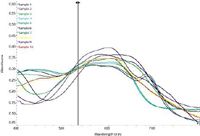
Figure 1: UVâvis absorption spectra of all 10 inks with the highlighted region (left and right black arrows) showing the location of the 532-nm laser excitation.
The two ink datasets (SERRS and non-SERRS) for all 10 inks were treated with identical chemometric analyses using Thermo Scientific TQ Analyst software. A discriminant analysis classification algorithm was chosen with which a unique distribution of variance for each class was calculated. This is similar to soft independent modeling of class analogy (SIMCA) in that it computes the sample variation of each class instead of computing a general variation for all classes. To aid in the chemometric analysis, a multiplicative signal correction (MSC) algorithm was also applied to account for the inherent differences in pathlength for each sample spectrum. A total of 15 principal components was used in the chemometric calculations and accounted for greater than 99% of the variation within the spectra. The spectra for both sample sets were analyzed using the second derivative and a Norris smoothing filter (segment length 17; gap distance four). The spectral region chosen for the analysis was between 1685 cm-1 and 1130 cm-1.
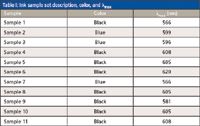
Table I: Ink sample set description, color, and λmax
Results and Discussion
A critical early determination of the current study was whether the signal enhancement noted in the ink samples included a resonant Raman effect. This question is readily addressed using UV–vis absorption spectroscopy. The resulting spectra are shown in Figure 1 and the maximum of each is shown in Table I. All the inks, both blue and black, had absorption maxima centered roughly around 600 nm. Using these spectra as a guide, we chose the 532-nm laser for the DXR spectrometer to gain the best sensitivity for the experiment versus the 633-nm laser. Whereas either the 532-nm or 633-nm laser would work well in terms of the resonant effect, the sensitivity increase from the higher frequency laser was desirable. The 780-nm laser was not chosen because all of the electronic transitions are at higher energy for these samples and would likely lead to a loss in sensitivity.
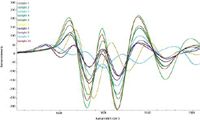
Figure 2: Second-derivative Raman spectra of representative spectra for each ink class showing the spectral similarities and differences.
The collected SERRS spectra are shown in Figure 2, with representative spectra of each ink class. Samples were prepared by marking the respective inks onto paper templates, mounting the templates onto slides, and automatically doing the analysis via Array Automation. Each ink spot was analyzed in a 13 × 13 grid totaling 169 spectra per ink. The spectra are shown as the second derivative for ease of discrimination both visually and within the discriminant analysis algorithm. Raman signal enhancement is evidenced by the single-point spectra of sample 1 shown in Figure 3. The signal-to-noise ratios of all of the spectra were calculated for both the SERRS-enhanced and nonenhanced samples by measuring the maximum peak height in the Raman shift range between 2000 cm-1 and 400 cm-1 and dividing it by the root mean square (RMS) noise taken from the relatively featureless region from 2450 cm-1 to 2000 cm-1. An average signal-to-noise ratio of all the SERRS-enhanced spectra was found to be 195, whereas the average across all nonenhanced spectra was 35, a fivefold increase. Individual spectra, however, exhibited signal-to-noise enhancement factors ranging from 8 to 250.
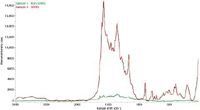
Figure 3: Signal-to-noise enhancement shown in sample 1.
As stated in the introduction, fluorescence reduction is known to be another advantageous SERRS effect. The mechanism of this reduction comes from the ability of the metal to provide the analyte a pathway for nonradiative decay in contrast to the native analyte alone. This, in itself, will result in lower fluorescence from the analyte as fluorescence arises via a radiative decay pathway. Figure 4 shows the difference for sample 9, a black permanent ink, in terms of fluorescence reduction. The non-SERRS spectrum has a broad baseline feature centered at 1300 cm-1 in addition to a broad, low-level feature centered at 2600 cm-1. The SERRS spectrum, in addition to excellent signal-to-noise improvements, exhibits none of the fluorescence found in the non-SERRS samples. The two spectra chosen for comparison in Figure 4 are representative of all the other spectra collected within the same spot. All the spectra originating from ink sample 9 without colloid exhibited significant fluorescence and had very poor signal-to-noise.
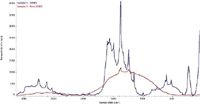
Figure 4: Fluorescence reduction of the SERRS-enhanced ink sample compared to the non-enhanced in sample 9.
The principal component (PC) scores plot for all 10 ink classes showing the PC 1 vs. PC 5 space is shown in Figure 5. Although in this view it is difficult to visually resolve all the ink clusters, the algorithm takes into account all the PCs in its analysis. The main thrust of the comparison is identifying the number of misclassified spectra within the PC analysis from SERRS to non-SERRS spectra while keeping the chemometric treatment identical. This should provide a reasonable guide to the integrity of discriminant classifications with SERRS measurements versus non-SERRS for highly similar, fluorescent compounds like inks. In addition, this will also shed some light on the reliability of the measurement in terms of a high-throughput laboratory. Among approximately 1500 spectra spanning 10 classes of inks, 97.3% of the SERRS-enhanced spectra were correctly identified and classified into their respective ink types compared to only 48.3% correctly identified for the nonenhanced samples. In addition, the majority of the remaining 2.7% misclassified for the SERRS spectra were due to the misclassification between only two ink classes, samples 4 and 5. These two inks were found to be extremely similar using a visual comparison of their Raman spectra, shown in Figure 6.
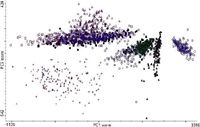
Figure 5: Principal component scores plot of PC1 versus PC5 showing discrimination between ink classes. This figure only shows one dimension of the discrimination solution so not all the classes are fully separated in this plot.
Conclusion
A total of 10 samples of commercial ink were analyzed using a dispersive Raman microscope. Significant signal enhancement was observed compared with the native samples, demonstrating the well-known SERRS enhancement. UV–vis spectra were collected on the same sample set spotted on a different support using diffuse transmittance to confirm that the functional mechanism is a resonant Raman effect (SERRS) when using a 532-nm excitation laser. In addition, a fluorescence suppression was noted, allowing for improved throughput. Array Automation sampling was also shown to be a significant time savings in routine analyses. SERRS Raman analysis has been shown to significantly increase the accuracy of discrimination among commercial ink samples using principal component techniques versus non-SERRS Raman analysis.
Jeffrey Hirsch is chief scientist for molecular and microanalysis, Timothy O. Deschaines is a product specialist, and Todd Strother is an applications scientist, all at Thermo Fisher Scientific in Madison, Wisconsin.
References
(1) M. Fleischmann, P.J. Hendra, and A.J. McQuillan, J. Chem. Phys. Lett. 26, 123 (1974).
(2) C.L. Haynes, C.R. Yonzon, X. Zhang, and R.P. Van Duyne, J. Raman. Spectrosc. 36, 471 (2005).
(3) D.L. Jeanmaire and R.P. Van Duyne, J. Electroanal. Chem. 84, 1 (1977).
(4) M.G. Albrecht and J.A. Creighton, J. Am. Chem. Soc. 99, 5215 (1977).
(5) M.R. Philpott, J. Chem. Phys. 62, 1812 (1975).
(6) M.J. Moskovits, J. Chem. Phys. 69, 4159 (1978).
(7) J.R. Lombardi and L.R. Birke, Acc. Chem. Res. 42(6), 734 (2009).
(8) S. Nie and S.R. Emory, Sci. 275, 1102 (1997).
(9) C. Rodger, G. Dent, J. Watkinson, and W.E. Smith, Appl. Spectrosc. 54, 1567 (2000).
(10) T. Andermann, Prob. Foren. Sci. XLVI, 335 (2001).
(11) E. Fabianska and M. Trzcinska, Prob. Foren. Sci. XLVI, 383 (2001).
(12) E. Wagner and S. Clement, Prob. Foren. Sci. XLVI, 437 (2001).
(13) R.M. Seifar, J.M. Verheul, F. Ariese, U.A.T. Brinkman, and C. Gooijer, Analyst 126, 1418 (2001).
(14) J. Zieba-Palus and M. Kunicki, Foren. Sci. Int. 158, 164 (2006).
(15) I. Geiman, M. Leona, and J.R. Lombardi J. Foren. Sci. 54, 947 (2009).
(16) J. Zieba-Palus and M. Kunicki, Foren. Sci. Int. 158, 164 (2006).
(17) T. Hirschfeld and B. Chase, Appl. Spectrosc. 40, 133 (1986).
(18) D.V. Martyshkin, R.C. Ahuja, A. Kudriavtsev, and S.B. Mirov, Rev. Sci. Instrum. 75, 630 (2004).
(19) A. Bachackashvilli, S. Efrima, B. Katz, and Z. Priel, Chem. Phys. Lett. 94, 571 (1983).
(20) K. Kneipp, G. Hinzmann, and D. Fassler, Chem. Phys. Lett. 99, 5 (1983).
(21) B. Pettinger, Chem. Phys. Lett. 110, 576 (1984).
(22) L. Xie, X. Ling, Y. Fang, J. Zhang, and Z. Liu JACS 131, 9890 (2009).
(23) J.D. Driskell, A.G. Seto, L.P. Jones, S. Jokela, R.A. Dluhy, Y.-P. Zhao, and R.A. Tripp, Biosens. Bioelectron. 24, 923 (2008).
(24) J. Guicheteau, L. Argue. D. Emge, A. Hyre, M. Jacobsen, and S. Christesen, Appl. Spectrosc. 62, 267 (2008).
(25) P.C. Lee and D. Meisel, J. Phys. Chem. 86, 3391 (1982).
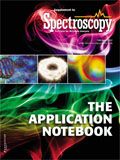
Nanometer-Scale Studies Using Tip Enhanced Raman Spectroscopy
February 8th 2013Volker Deckert, the winner of the 2013 Charles Mann Award, is advancing the use of tip enhanced Raman spectroscopy (TERS) to push the lateral resolution of vibrational spectroscopy well below the Abbe limit, to achieve single-molecule sensitivity. Because the tip can be moved with sub-nanometer precision, structural information with unmatched spatial resolution can be achieved without the need of specific labels.
Tomas Hirschfeld: Prolific Research Chemist, Mentor, Inventor, and Futurist
March 19th 2025In this "Icons of Spectroscopy" column, executive editor Jerome Workman Jr. details how Tomas B. Hirschfeld has made many significant contributions to vibrational spectroscopy and has inspired and mentored many leading scientists of the past several decades.